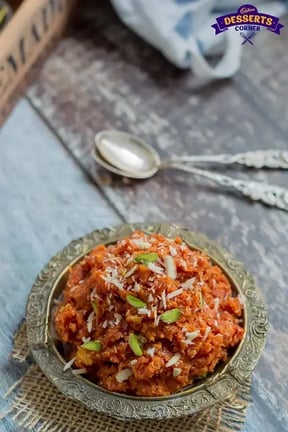Home![]() Articles
Articles![]() The History, Varieties and Enduring Appeal of the Much Loved Halwa Throughout India
The History, Varieties and Enduring Appeal of the Much Loved Halwa Throughout India
Once the halwa reached the Indian subcontinent from Persia, locals quickly made it their own. Today, there’s a large variety of halwas one can find, sprinkled in different regions of the country.

Once the halwa reached the Indian subcontinent from Persia, locals quickly made it their own. Today, there’s a large variety of halwas one can find, sprinkled in different regions of the country.
Halwa is a textured dessert that comes in several varieties across India, with everyone adapting it to their own tastes and locally available ingredients. Among them are Rajasthan’s moong dal halwa, Pune’s hari mirch halwa, West Bengal’s scholar dal halwa, UP and Bihar’s anda halwa, Karnataka’s kashi halwa, Kerala’s karutha halwa and other varieties including badam ka halwa, gajar halwa and more.
For a home cook in India, making halwa is almost like a rite of passage. It’s time consuming, taking over an hour to make, and it can be tricky to get the measurements of the ingredients and cooking techniques just right. It can burn easily or remain raw if not cooked enough. The taste could be funny if the proportions of ingredients are off. But it’s a fun and satisfying dessert to make once you've gotten the hang of it. Special occasions and festivals often see halwa being made in many Indian homes. And up in the north, during the winter season, the hot, ghee laden halwa helps keep people warm.

Its origins are slightly contentious, but it’s certainly a foreign dish that was popularized in the country. The word halwa comes from the Arabic word ‘hulw,’ meaning sweet. The process of cooking the halwa apparently comes from the Ottoman Empire, where Suleiman, the 10th and longest ruling Sultan, had a separate kitchen where only sweet items were made. Halwa was one of the more popular dishes there, made at the time using starch, fat and a sweetener.
Another theory suggests that halwa comes from the Turkish ‘helva,’ which itself comes from the Byzantine empire, around the 12th-century CE. Many food historians agree that the first halwa recipe is seen in the 13th-century Arabic book Kitab al-Tabikh (The Book of Dishes) by Muhammad Ibn al-Hasan Ibn al-Karīm. The book has not just one but eight halwa recipes. According to Guzishta Lucknow, a book by Abdul Halim Sharar, halwa reached the Indian subcontinent through Persia. But another book, Feasts and Fasts, by Colleen Taylor Sen, says that it came to the subcontinent between the 13th and 16th centuries, to the Delhi Sultanate, during Mohammad Bin Tughlaq’s rule.
The 16th century text Ain-i-Akbari by Abul Fazal, Akbar’s court historian, mentions halwa as one of the dishes Akbar ate during safiyana, which is the 10 days when he abstained from meat. Thomas Roe’s chaplain Edward Terry mentions halwa as an item eaten by poorer Muslims during breakfast, alongside naan, keema and dried fruits.
The enduring appeal of gajar ka halwa lies in its ability to balance the sweetness of the sugar with the natural earthiness of the carrots, creating a dessert that is indulgent but not overpowering. Its velvety texture, rich aroma, and refreshing flavor captivate food enthusiasts the world over, ensuring its position as a global favorite when it comes to desserts.
Here’s a recipe of the super famous gajar ka halwa or carrot halwa:

Ingredients:
- 8 carrots, grated
- 4 cups whole milk
- 4 tbsp ghee
- 12 tbsp sugar
- 1 tsp cardamom powder
- 12 cashews, chopped
- 12 almonds, sliced
- 2 tbsp raisins
- 1 pinch saffron strands
Directions:
- Rinse, peel and grate the carrots.
- In a kadhai, add the milk and grated carrots. Let it come to a boil on low heat until it starts to simmer. Keep stirring occasionally to make sure it doesn’t stick to the sides of the vessel.
- The milk will start reducing and evaporating as the carrots cook. Once the milk is 75% cooked, add the ghee, sugar and cardamom and mix well.
- Once the mixture is close to being cooked, add the cashews, almonds, saffron and raisins. Keep simmering until all the milk has evaporated and turn off the stove.
- Serve warm with chopped nuts as garnish.
Fun fact:
- In the 17th century, the Dutch created orange carrots as a way of paying tribute to William of Orange. From there, they traveled to Afghanistan and through that route, reached India, which then led to the gajar ka halwa being invented.
- In Sheeren Bhawan, a shop in Old Delhi, one can find halwa made from white carrots, which come from Ghaziabad in Uttar Pradesh, and are only available between mid-December and mid-Febraury.
- In Lucknow, one can find a black carrot halwa, since the vegetable is easily available in the markets there.






















